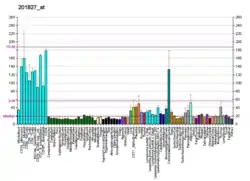| SMARCD2 | |||||||||||||||||||||||||||||||||||||||||||||||||||
|---|---|---|---|---|---|---|---|---|---|---|---|---|---|---|---|---|---|---|---|---|---|---|---|---|---|---|---|---|---|---|---|---|---|---|---|---|---|---|---|---|---|---|---|---|---|---|---|---|---|---|---|
| Identifiers | |||||||||||||||||||||||||||||||||||||||||||||||||||
| Aliases | SMARCD2, BAF60B, CRACD2, Rsc6p, PRO2451, SWI/SNF related, matrix associated, actin dependent regulator of chromatin, subfamily d, member 2, SGD2 | ||||||||||||||||||||||||||||||||||||||||||||||||||
| External IDs | OMIM: 601736 MGI: 1933621 HomoloGene: 20671 GeneCards: SMARCD2 | ||||||||||||||||||||||||||||||||||||||||||||||||||
| |||||||||||||||||||||||||||||||||||||||||||||||||||
| |||||||||||||||||||||||||||||||||||||||||||||||||||
| |||||||||||||||||||||||||||||||||||||||||||||||||||
| |||||||||||||||||||||||||||||||||||||||||||||||||||
| |||||||||||||||||||||||||||||||||||||||||||||||||||
| Wikidata | |||||||||||||||||||||||||||||||||||||||||||||||||||
| |||||||||||||||||||||||||||||||||||||||||||||||||||
SWI/SNF-related matrix-associated actin-dependent regulator of chromatin subfamily D member 2 is a protein that in humans is encoded by the SMARCD2 gene.[5][6][7]
The protein encoded by this gene is a member of the SWI/SNF family of proteins, whose members display helicase and ATPase activities and which are thought to regulate transcription of certain genes by altering the chromatin structure around those genes. The encoded protein is part of the large ATP-dependent chromatin remodeling complex SNF/SWI and has sequence similarity to the yeast Swp73 protein.[7]
References
- 1 2 3 GRCh38: Ensembl release 89: ENSG00000108604 - Ensembl, May 2017
- 1 2 3 GRCm38: Ensembl release 89: ENSMUSG00000078619 - Ensembl, May 2017
- ↑ "Human PubMed Reference:". National Center for Biotechnology Information, U.S. National Library of Medicine.
- ↑ "Mouse PubMed Reference:". National Center for Biotechnology Information, U.S. National Library of Medicine.
- ↑ Wang W, Xue Y, Zhou S, Kuo A, Cairns BR, Crabtree GR (Nov 1996). "Diversity and specialization of mammalian SWI/SNF complexes". Genes Dev. 10 (17): 2117–30. doi:10.1101/gad.10.17.2117. PMID 8804307.
- ↑ Ring HZ, Vameghi-Meyers V, Wang W, Crabtree GR, Francke U (Sep 1998). "Five SWI/SNF-related, matrix-associated, actin-dependent regulator of chromatin (SMARC) genes are dispersed in the human genome". Genomics. 51 (1): 140–3. doi:10.1006/geno.1998.5343. PMID 9693044.
- 1 2 "Entrez Gene: SMARCD2 SWI/SNF related, matrix associated, actin dependent regulator of chromatin, subfamily d, member 2".
Further reading
- Wang W, Côté J, Xue Y, et al. (1996). "Purification and biochemical heterogeneity of the mammalian SWI-SNF complex". EMBO J. 15 (19): 5370–82. doi:10.1002/j.1460-2075.1996.tb00921.x. PMC 452280. PMID 8895581.
- Surabhi RM, Daly LD, Cattini PA (1999). "Evidence for evolutionary conservation of a physical linkage between the human BAF60b, a subunit of SWI/SNF complex, and thyroid hormone receptor interacting protein-1 genes on chromosome 17". Genome. 42 (3): 545–9. doi:10.1139/gen-42-3-545. PMID 10382302.
- Bochar DA, Wang L, Beniya H, et al. (2000). "BRCA1 is associated with a human SWI/SNF-related complex: linking chromatin remodeling to breast cancer". Cell. 102 (2): 257–65. doi:10.1016/S0092-8674(00)00030-1. PMID 10943845. S2CID 6500100.
- Strausberg RL, Feingold EA, Grouse LH, et al. (2003). "Generation and initial analysis of more than 15,000 full-length human and mouse cDNA sequences". Proc. Natl. Acad. Sci. U.S.A. 99 (26): 16899–903. Bibcode:2002PNAS...9916899M. doi:10.1073/pnas.242603899. PMC 139241. PMID 12477932.
- Nie Z, Yan Z, Chen EH, et al. (2003). "Novel SWI/SNF chromatin-remodeling complexes contain a mixed-lineage leukemia chromosomal translocation partner". Mol. Cell. Biol. 23 (8): 2942–52. doi:10.1128/MCB.23.8.2942-2952.2003. PMC 152562. PMID 12665591.
- Lehner B, Sanderson CM (2004). "A protein interaction framework for human mRNA degradation". Genome Res. 14 (7): 1315–23. doi:10.1101/gr.2122004. PMC 442147. PMID 15231747.
- Gerhard DS, Wagner L, Feingold EA, et al. (2004). "The status, quality, and expansion of the NIH full-length cDNA project: the Mammalian Gene Collection (MGC)". Genome Res. 14 (10B): 2121–7. doi:10.1101/gr.2596504. PMC 528928. PMID 15489334.
- Beausoleil SA, Villén J, Gerber SA, et al. (2006). "A probability-based approach for high-throughput protein phosphorylation analysis and site localization". Nat. Biotechnol. 24 (10): 1285–92. doi:10.1038/nbt1240. PMID 16964243. S2CID 14294292.
- Olsen JV, Blagoev B, Gnad F, et al. (2006). "Global, in vivo, and site-specific phosphorylation dynamics in signaling networks". Cell. 127 (3): 635–48. doi:10.1016/j.cell.2006.09.026. PMID 17081983. S2CID 7827573.
This article is issued from Wikipedia. The text is licensed under Creative Commons - Attribution - Sharealike. Additional terms may apply for the media files.




